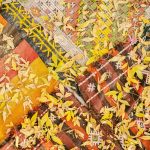Yes, lawn fabric can shrink, especially if it’s made from natural fibers like cotton, which absorb moisture and respond to heat by contracting. Synthetic blends resist shrinking better but aren’t completely immune. Factors like tight weaving, exposure to sunlight, and fluctuating moisture levels affect how much it shrinks. You’ll notice tightening, wrinkling, or edges pulling up if it does. If you want to keep your lawn fabric lasting longer and avoid shrinkage, there are helpful tips and alternatives to explore.
Table of Contents
Key Takeaways
- Cotton-based lawn fabric can shrink due to moisture absorption and improper handling during washing or installation.
- Synthetic fibers blended with cotton reduce shrinkage risk and increase fabric durability and wrinkle resistance.
- Signs of lawn fabric shrinkage include tighter fabric, wrinkling, edges pulling inward, and fasteners straining.
- Fluctuating moisture and temperature changes cause fabric expansion and contraction, contributing to shrinkage over time.
- Prevent shrinkage by limiting direct sunlight exposure, properly stretching fabric, and maintaining consistent moisture levels.
What Is Lawn Fabric Made Of
Lawn fabric is typically made from tightly woven cotton or a blend of cotton and synthetic fibers.
Lawn fabric combines tightly woven cotton with synthetic fibers for a lightweight, breathable textile.
When you choose lawn fabric, you’re selecting a lightweight material known for its smooth texture and breathability.
Cotton-based lawn offers natural softness and comfort, making it ideal for warm weather.
If the fabric contains synthetic fibers like polyester, it gains added strength and wrinkle resistance, which makes it easier to care for.
You’ll find that pure cotton lawn tends to absorb moisture well, but it can also be prone to shrinking if not handled properly.
Blends, on the other hand, reduce that risk while maintaining a similar feel.
Understanding what lawn fabric is made of helps you anticipate how it might respond to washing, drying, and wearing.
How Lawn Fabric Is Manufactured
You’ll find that lawn fabric starts with high-quality raw materials like fine cotton or linen fibers.
The weaving techniques then create its smooth, lightweight texture, while finishing processes add durability and softness.
Understanding these steps helps you see why lawn fabric behaves the way it does.
Raw Materials Used
Manufacturers rely on synthetic fibers like polypropylene and polyester to create durable, weather-resistant fabric.
When you choose lawn fabric, you’re getting a material designed to resist moisture, UV rays, and mildew.
Polypropylene offers excellent tensile strength and chemical resistance, making your fabric less likely to tear or degrade over time.
Polyester adds flexibility and color retention, so your fabric maintains its look even under harsh sunlight.
Sometimes, manufacturers blend these fibers to balance strength and comfort.
You’ll also find additives like UV stabilizers or anti-microbial agents mixed in to enhance performance.
These raw materials guarantee the fabric holds up well outdoors and maintains its size and shape, reducing worries about shrinkage after exposure to water or sun.
Weaving Techniques
The choice of raw materials sets the foundation, but how the fibers are woven plays a big role in the fabric’s final performance. Lawn fabric typically uses a plain weave, where warp and weft threads cross tightly and evenly. This technique gives you a smooth, lightweight texture with good breathability. The tight weave also helps reduce shrinkage, as the fabric holds its shape better during washing.
Here’s a quick overview of common weaving techniques in lawn fabric manufacturing:
| Weaving Technique | Impact on Fabric |
|---|---|
| Plain Weave | Smooth, lightweight, durable |
| Twill Weave | Heavier, diagonal pattern |
| Satin Weave | Shiny, less durable |
Understanding these helps you choose the right lawn fabric for your needs.
Finishing Processes
Although weaving sets the fabric’s structure, finishing processes give lawn fabric its final look and feel.
Once the fabric is woven, you’ll notice it undergoes bleaching to achieve that bright, clean base color.
Then, it’s mercerized, which strengthens the fibers and adds a subtle sheen.
You’ll find that the fabric is also treated with softeners to enhance its smooth, silky texture, making it comfortable against your skin.
Finally, it’s calendared—passed through heated rollers—which gives lawn fabric its crisp finish and slight translucency.
These finishing steps don’t just improve aesthetics; they stabilize the fabric, reducing shrinkage and ensuring durability.
Common Uses for Lawn Fabric
When you’re looking to control weeds without harsh chemicals, lawn fabric offers an effective solution. You can use it to promote a healthy garden environment while minimizing maintenance.
Here are some common uses for lawn fabric you might find helpful:
- Weed Control: Place it under mulch or gravel to block sunlight, preventing weed growth.
- Soil Erosion Prevention: Lay it on slopes or bare soil to reduce erosion during heavy rains.
- Plant Bed Preparation: Use it to separate soil layers and improve drainage, encouraging stronger root development.
Factors That Can Cause Lawn Fabric to Shrink
You’ll want to contemplate several factors that can cause lawn fabric to shrink.
The material composition plays a big role, along with how environmental exposure affects it over time.
Plus, how you install and maintain the fabric can make a noticeable difference.
Material Composition Impact
Since lawn fabric is made from various materials, its tendency to shrink depends heavily on the fibers used.
When you’re selecting or evaluating lawn fabric, understanding the material composition is key to predicting shrinkage. Different fibers react uniquely to stress, moisture, and heat, which can cause dimensional changes.
Here’s what you need to know about common materials:
- Polypropylene: Highly resistant to shrinkage due to its synthetic nature, making it a reliable choice for durability.
- Polyester: Offers moderate shrink resistance but can shrink slightly when exposed to heat.
- Natural fibers (like jute or cotton): Prone to shrinking because they absorb moisture and respond more actively to environmental changes.
Environmental Exposure Effects
Although lawn fabric’s material plays a major role, environmental exposure greatly affects its tendency to shrink. When you leave your lawn fabric exposed to intense sunlight for long periods, UV rays can degrade the fibers, causing them to contract and shrink.
Similarly, extreme temperature fluctuations make the fabric expand and contract repeatedly, which may weaken its structure and lead to permanent shrinking over time.
Moisture is another factor; frequent exposure to rain or irrigation can cause certain fabrics to absorb water and then dry unevenly, resulting in dimensional changes.
If you live in a windy area, constant movement and abrasion against debris can also stress the fabric’s fibers, contributing to shrinkage.
Understanding these environmental factors helps you anticipate how your lawn fabric might behave outdoors.
Installation and Maintenance Factors
When you install lawn fabric improperly or neglect its upkeep, you’re more likely to see it shrink prematurely. Incorrect installation can stretch the fabric unevenly, causing tension that leads to shrinking.
Failing to secure it properly allows movement and bunching, which also contributes to shrinkage. Additionally, poor maintenance accelerates wear and tear, making the fabric lose its shape.
To prevent lawn fabric from shrinking, focus on these key factors:
- Make certain you lay the fabric flat without overstretching during installation.
- Use enough stakes or pins to keep the fabric firmly in place.
- Regularly inspect and adjust the fabric, especially after heavy weather or garden work.
Effects of Sunlight and UV Exposure on Lawn Fabric
Exposure to sunlight and UV rays can considerably impact the durability and performance of lawn fabric. When you leave the fabric exposed for long periods, UV radiation breaks down its fibers, causing them to weaken and become brittle.
This deterioration reduces the fabric’s effectiveness in controlling weeds and supporting soil stability. You might notice the fabric becoming discolored or developing small cracks over time, which compromises its integrity.
To protect your lawn fabric, consider using UV-resistant options or applying protective covers during peak sunlight hours. Taking these steps helps maintain the fabric’s strength and prolongs its lifespan, ensuring that it continues to perform well without shrinking or failing prematurely due to sun damage.
Impact of Moisture and Temperature Changes on Lawn Fabric
Since lawn fabric often deals with fluctuating moisture levels and temperature swings, these factors can greatly affect its performance and longevity.
Moisture causes the fabric to expand as it absorbs water, then contract when it dries, which can lead to stretching or warping over time. Temperature changes also influence the material’s flexibility and strength, sometimes making it brittle in cold weather or overly soft in heat.
Lawn fabric expands with moisture and contracts when dry, while temperature shifts affect its flexibility and strength.
Keep these in mind:
- Excessive moisture can weaken fibers, reducing durability.
- Rapid temperature shifts stress the fabric, increasing wear.
- Consistent wet-dry cycles may cause minor dimensional changes but rarely permanent shrinkage.
Signs Your Lawn Fabric Is Shrinking
You’ll notice your lawn fabric feels tighter than before, making it harder to adjust or stretch.
Wrinkling patterns may also appear where the fabric has contracted unevenly.
These signs usually indicate that your lawn fabric is shrinking.
Fabric Tightness Changes
When lawn fabric starts shrinking, one of the first signs you’ll notice is a change in its tightness. You might feel the material pulling more tightly across the ground, making it harder to stretch or adjust.
This tightening can affect how well the fabric stays in place and how it interacts with soil and plants. Watch for these specific changes:
- The fabric feels less flexible when you try to reposition it.
- Edges that once lay flat now pull upward or inward.
- Fasteners or staples holding the fabric seem to strain or loosen due to the tension.
Noticing these tightness shifts early helps you address shrinking before it causes damage or affects your lawn’s health.
Visible Wrinkling Patterns
Several distinct wrinkling patterns can reveal that your lawn fabric is shrinking. When fabric pulls tighter than usual, you’ll notice small, sharp wrinkles forming across its surface.
These wrinkles often appear in a grid-like or diagonal pattern, signaling uneven tension caused by shrinkage. You might also see puckering around edges or seams, where fabric contracts more than the surrounding area.
If you spot these irregular folds or ripples, it’s a clear sign your lawn fabric isn’t holding its original size. Keep an eye out for wrinkles that worsen after watering or sun exposure, as these environmental factors accelerate shrinkage.
Addressing the issue early helps maintain your lawn’s health and prevents fabric damage. Recognizing these visible wrinkling patterns lets you act before problems escalate.
How to Prevent Lawn Fabric From Shrinking
Although lawn fabric can shrink over time, you can take specific steps to minimize this effect and keep your fabric in good condition.
First, avoid exposing the fabric to excessive heat, such as direct sunlight for prolonged periods, which can cause fibers to contract.
Second, guarantee proper installation by stretching the fabric taut but not overly tight, preventing tension that leads to shrinkage.
Third, maintain appropriate moisture levels; overwatering or allowing water to pool can weaken fibers, accelerating shrinkage.
To summarize, focus on these key actions:
- Limit prolonged sun exposure
- Install fabric with correct tension
- Manage watering to avoid saturation
Alternatives to Lawn Fabric That Resist Shrinking
If you want a ground cover that won’t shrink, you can explore alternatives to traditional lawn fabric designed to withstand environmental stress better.
One option is woven polypropylene landscaping fabric, which offers superior durability and resists shrinking under heat and moisture.
Another choice is rubber mulch mats; these don’t shrink and provide excellent weed control while allowing water to pass through.
You might also consider geotextile fabrics made from synthetic fibers; they maintain their shape and strength over time.
For a natural approach, using thick layers of organic mulch like wood chips or bark can suppress weeds without any shrinking issues.
Each alternative has unique benefits, so choose one based on your garden’s needs, ensuring long-lasting coverage without the frustration of shrinking fabric.
Tips for Maintaining Lawn Fabric Longevity
To keep your lawn fabric effective and extend its lifespan, you should regularly inspect it for tears or gaps that let weeds through. Catching damage early prevents bigger issues and keeps the fabric working as intended.
Additionally, avoid piling heavy objects on the fabric to prevent stretching or tearing. Proper installation also plays a significant role; make sure the fabric lies flat and is secured well.
Here are some quick tips to maintain your lawn fabric’s longevity:
- Remove debris and fallen leaves regularly to prevent moisture buildup and mold growth.
- Use a sharp utility knife for trimming to avoid unnecessary fraying.
- Avoid exposing the fabric to harsh chemicals or excessive sunlight for prolonged periods.
Following these steps helps your lawn fabric last longer and stay effective.
Frequently Asked Questions
Can Lawn Fabric Be Safely Used Under Artificial Turf?
You can safely use lawn fabric under artificial turf to prevent weeds and improve drainage. Just make sure it’s durable and UV-resistant, so it won’t break down or shrink over time, keeping your turf intact.
Is Lawn Fabric Biodegradable or Environmentally Friendly?
Did you know 80% of lawn fabrics are made from synthetic materials that aren’t biodegradable? You won’t find them environmentally friendly, so if you care about sustainability, consider natural alternatives instead of traditional lawn fabric.
How Long Does Lawn Fabric Typically Last Before Replacement?
You can expect lawn fabric to last about 3 to 10 years, depending on quality and exposure to sunlight. Proper installation and maintenance can extend its lifespan before you need to replace it.
Can Lawn Fabric Affect Soil Health or Plant Growth?
You should know lawn fabric can impact soil health by limiting water and air flow, which might stunt plant growth. However, using breathable, high-quality fabric helps maintain healthy soil while controlling weeds effectively.
Are There Specific Tools Recommended for Installing Lawn Fabric?
You’ll want a utility knife to cut the fabric, landscape staples or pins to secure it, and a garden rake to smooth the soil before laying. These tools make installation easier and keep the fabric in place.
- Tetron Fabric for Marine Applications: Durability and Use Cases - June 18, 2025
- Tetron Fabric for Outdoor Furniture: Weather Resistance and Care - June 18, 2025
- Tetron Fabric for Wall Coverings: Style and Application Tips - June 18, 2025







